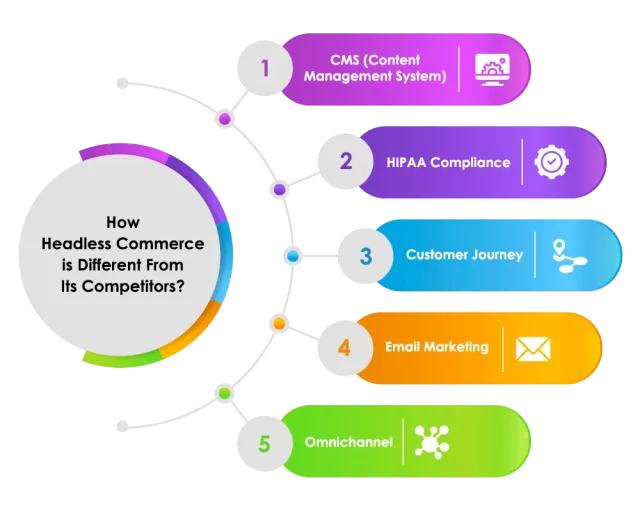Cyntexa Successfully Hosted Live Webinar on Headless Commerce in Salesforce Commerce Cloud
Introduction
The eCommerce world is constantly changing, be it market trends, customer preferences or expectations, or business needs. We can say it’s emerging diversely.
Technology has evolved rapidly with the hike in online shopping in the 1990s. Previously, businesses were relying on a full-stack approach for their eCommerce store that had a close connection between the front & back end.
This all worked out as they were only introduced to one mode i.e. desktop.
But with the rising inflation and in the middle of the global supply chain crisis, businesses are finding a way to keep up with new market trends and adapt latest technological upgradation.
Recently Salesforce Commerce Cloud has successfully drawn the attention of many businesses towards its new launch, i.e., Headless Commerce in Salesforce Commerce Cloud.
In this blog, look at how brands would be satisfying business needs by utilizing headless commerce’s adaptability and agility.
What is Headless Commerce?
Headless commerce is an approach to e-commerce that provides organizations with agility and flexibility to experiment and test, and effectively separate the front and back end of their e-commerce experiences.
With this architecture, businesses can construct anything they desire. It specifically allows companies to improve the consumer experience.
The utilization of experience managers, APIs, technologies like Heroku and Mulesoft, and IT partners’ significance are some of the characteristics of headless commerce. Every company’s innovation plan must include these resources. It is because they bring new features and experiences that engage customers and exceed their expectations.
Dealing in eCommerce, you must be very familiar with the challenges of keeping up with the latest experiences and touchpoints. Traditional e-commerce models can make even minor initiatives difficult. This is because front-end and back-end systems might not be updated to accommodate new experiences.
How Headless Commerce is Different From Its Competitors?

Let’s discuss what makes Headless Commerce different from its competitors on different grounds:
CMS (Content Management System):
A Content Management System is a software platform. It enables the users to create, modify, organize, sort, manage and deliver digital content from a centralized location.
Headless Commerce offers its Headless Content Integration, unlike WooCommerce, which provides CMS plugins through WordPress.
HIPAA Compliance:
HIPAA compliance is a method that business associates and covered organizations use to preserve and secure Protected Health Information (PHI). This is in accordance with the Health Insurance Portability and Accountability Act. Legal meaning of which is “keeping people’s healthcare data private.”
Compared to its competitors, Shopify, WooCommerce, and Magento, Headless Commerce Cloud provides HIPAA Compliance features.
Customer Journey:
It includes all the phases of an online customer’s interaction with a business. These phases includes steps starting from the first ever encounter to products till the final purchase. Headless commerce lets you view, map, and analyze it on one platform. Whereas, WooCommerce and Magento are still supporting 3rd parties to provide this service.
Email Marketing:
One of the most popular and growing techniques that allow businesses to target specific groups of customers is Email Marketing. Where Shopify is allowing to send 1000 free emails and charging $1 per email once this limit is exceeded. Magento involves 3rd party to offer email marketing, Headless commerce is coming with this feature at zero cost.
Omnichannel:
Regarding sales, omnichannel refers to a multichannel strategy that focuses on delivering a seamless customer experience. Whether the customer is purchasing online or directly from a physical store. Popular eCommerce platforms like WooCommerce, Magento, and Shopify haven’t listed this feature in their services, but Headless Commerce did, making it stand out from the competition.
Benefits of Headless Commerce in Salesforce Commerce Cloud
Larger businesses frequently use Headless Commerce in Salesforce Commerce Cloud with larger IT and development teams and a DIY mindset. This fits in the picture as bespoke programming may necessitate a considerable time commitment to develop and design a reliable distinct front end and back end.
Mostly, companies have lengthy development backlogs, ambitious, and creative marketing teams ready to test new layouts, content, and templates immediately.
Businesses need to move to Headless commerce; want to know why?
Here are the top 5 reasons that sync with every business’s requirements:
- Scalability of Systems: Another major reason why many organizations prefer headless commerce architecture is it has the potential to scale faster. Because all platforms are connected to a common back-end architecture, headless commerce enables companies to expand considerably more quickly than traditional commerce models.
- Personalization and customization: Users, developers, and marketers may only utilize a limited number of themes when utilizing a traditional e-commerce technique that standardizes and monotonizes the user experience. Because of headless commerce, your website will not be connected with the standard clichés used by the great majority of businesses and you will be having unique offerings, visualization, and customer journeys. It will inspire your website visitors to buy and better meet their demands.
- PWAs (Progressive Web Apps): Although PWA is not a part of Salesforce Headless Commerce, it can serve as the ideal springboard for “complete decapitation.” A PWA launched separately from the backend has a flexible and adaptable architecture and is quicker, mobile, and SEO-friendly.
- Endless UI and UX control: Decoupling units relieve businesses’ control over marketing and user experience by enabling developers to operate freely at the front end without affecting the back end. They may employ cutting-edge techniques to develop aesthetically beautiful user interfaces, omnichannel experiences, and compelling web experiences. They may also introduce a new product line, touchpoints, targeting a different consumer in matter of hours instead of months.
- Optimized developer experience: The “Legacy Phase” of monolith architecture is accompanied by the need to maintain infrastructure and resolve technological challenges. Businesses must deploy huge IT teams with knowledge in traditional frameworks like C, Pascal, Cobol, DB2,.NET, or JAVA to make operations run more smoothly and efficiently. Headless Commerce freed up space for developers to build modern features that were previously spent on maintenance of such systems.
SFRA and Its Features
A reference architecture combines best practices for site design and storefront architecture and serves as a starting point for designing an online storefront. It provides you with a framework for developing and personalizing your online shops.
The Storefront Reference Architecture (SFRA) blends industry best practices and anticipated out-of-the-box commerce features into an online storefront that may operate as the building block of your new Salesforce Commerce B2C site.
Consider SFRA as a tool that helps you launch on the platform in less time and with a rapid approach to begin your Salesforce B2C Commerce Cloud project.
There are numerous pre-installed features, such as the homepage, checkout, cart, product detail pages, and more. Additionally, it enables businesses to swiftly integrate technologies such as Google Pay, Apple Pay, Amazon Pay, etc. Hence, making it simple for customers to purchase on mobile devices.
Features:
- Enhances time to market: Developers can quickly benefit by utilizing the prebuilt storefront templates and design.
- Reduces storefront TCO (Total Cost of Ownership): With the launch of the new reference application, developers got an easy-to-use code base to add features quickly.
- Elevates the mobile shopping experience: The main thought of Salesforce behind designing SFRA is to provide a framework that is mobile-user friendly and adapts flawlessly to every screen size. It also offers an enhanced shopping experience on any device.
- Storefront Ownership and free personalization: Integrations are distinct from the main code base, allowing developers to take ownership of the code and modify it to suit the specific requirements of their brand.
What Is PWA Kit & How It Can Improve Your Storefront?
The PWA Kit is a dynamic web app for Commerce Cloud. This web app lets you smoothly switch your online shop to a headless commerce architecture.
With the Salesforce Commerce Cloud platform’s expanded functionality and the PWA Kit, you can deploy more quickly and inexpensively while offering app-like interaction across mobile, tablet, and desktop.
Let’s see how PWA Kit can add value to improving the performance of your storefront:
Ensure smooth, customized interactions Create unique, captivating experiences that resemble apps across all touchpoints. Hence, improving efficiency and providing a smooth consumer experience.
- Go to market faster: Businesses can utilize the PWA Kit to implement headless concepts in a contemporary, decoupled storefront without the enormously long lead time that comes with traditional headless projects.
- Expand Your Flexibility: Deploy a platform that can change the environment and expand along with your company.
- Think creatively: Focus on developing cutting-edge consumer experiences and content instead than spending as much time managing infrastructure.
How to Select the Right Implementation Partner For Headless Commerce?
There are so many teams around the globe having expertise in the new Headless CMS implementation. But, you need the best one and the all-rounder who can fill in all the rooms of doubt and provide you with an impeccable experience.
That’s where Cyntexa backs you up in the high-time demand of headless CMS implementation. Let’s find out how Cyntexa fits into the frame of the Right Implementation Partner for Headless Salesforce Commerce Cloud:
Experience With Previous CMS: Prior experience with tools and frameworks is always a cherry on the pie. Just like Cyntexa can help your business streamline the headless migration process.
Project Management Approach: Management of implementation throughout could be critical. An implementation partner like Cyntexa will always be at the forefront of structuring the project team and making it a stress-free job for you.
Methodology: They say the best dish always needs the perfect method and ingredients. With Cyntexa as your right-hand implementation partner, you will never have to compromise on getting the best possible solution.
Connected Ecosystem: Salesforce has a connected ecosystem. Therefore, you should look for partners like Cyntexa who have an experience with numerous Salesforce offerings.
About Cyntexa & Webinar
Cyntexa, organized a Live Webinar on July 28, 2022, covering a highlighted discussion on several critical points associated with Headless Commerce in Salesforce Commerce Cloud and how it’s a big changer for Businesses. We specialize in extending the capabilities of headless commerce architecture with custom Salesforce development solutions built to scale and designed to perform.
Take a sneak peek at the video of the Live Webinar
Don’t Worry, We Got You Covered!
Get The Expert curated eGuide straight to your inbox and get going with the Salesforce Excellence.



